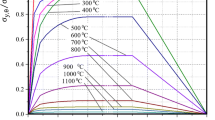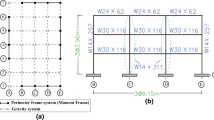Abstract
Fire following earthquake can cause substantially loss of life and property, added to the destruction already caused by the earthquake, and represents an important threat in seismic regions. On the other hand, even when no fire develops immediately after an earthquake, the possibility of later fires affecting the structure must be adequately taken into account, since the earthquake induced damages make the structure more vulnerable to fire effects than the undamaged one. The paper presents the evaluation of the fire resistance time for some unprotected steel moment resisting frames, in the hypothesis that they are already damaged by the earthquake, using advanced methods for earthquake and subsequent fire analysis, and using both standard and natural fire scenarios. Moderate and severe seismic actions are used for designing the steel structures. The influence of the damage level induced by the earthquake on the fire resistance is emphasized.
Similar content being viewed by others
References
All-Industry Research Advisory Council (1987). Fire following earthquake, Estimation of the conflagration risk to insured property in Los Angeles and San Francisco. Oak Brook, IL, USA.
Botting, R. (1998). The impact of post-earthquake fire on the built urban environment. Fire engineering research report 98/1, University of Canterbury, New Zealand.
Buchanan, A. H. (2001). Structural design for fire safety. John Wiley & Sons, UK.
Cadorin, J. F., Pintea, D., Dotreppe, J. C, and Franssen, J. M. (2003). “A tool to design steel elements submitted to compartment fires- Ozone V2. Part2: Methodology and application.” Fire safety Journal, 38, pp. 439–451.
CEC Agreement 7210-PA/PB/PC/PD/PE/PF/PR-060 (2001). Natural Fire Safety Concept. Implementation in the Eurocodes and Development of an User friendly Design Tool.
Chen, S., Lee, G. C, and Shinozuka, M. (2004). “Hazard mitigation for earthquake and subsequent fire.” ANCER Annual Meeting: Networking of Young Earthquake Engineering researchers and Professionals, Honolulu, Hawaii.
Collier, P. C. R. (2008). “Post-earthquake performance of passive fire protection systems.” Proceedings of the fifth International Conference on Structures in Fire, Singapore, pp. 748–759.
Cousins, W. J., Dowrick, D. J., and Sritharan, S. (1991). “Fire following earthquake.” Proc. Institution of Fire Engineers Conference, New Plymouth.
Cousins, W. J., Thomas, G. C, Heron, D. W., Mazzoni, S., and Lloydd, D. (2002). “Modelling the spread of post- earthquake fire in Wellington City.” Proc. Of the 2002 Technical Conference and AGM, New Zealand Society for Earthquake Engineering, Napier, pp. 15–17.
Evans, D. D., Walton, W. D., and Mowrer, F. W. (1997). “Progress report on fires following the Northridge earthquake.” Thirtheen meeting of the UJNR panel on fire research and safety, Vol. 2, UJNR Panel on Fire Research and Safety, USA.
Delia, C. G, Faggiano, B., and Mazzolani, F. M. (2005). On the structural effects of fire following earthquake. Improvement of buildings, Taylor & Francis Group, London, UK.
EN 1990 (2004). Eurocode: Basis of Design. European Comittee for Standardisation, Brussels.
EN 1991-1-2 (2005). Eurocode 1 — Actions on structures — Part 1-2: General actions — Actions on structures exposed to fire. European Committee for Standardization, Brussels.
EN 1993-1-2 (2005). Eurocode 3: Design of steel structures -Part 1-2: General rules-Structural fire design. European Committee for Standardization, Brussels.
EN 1998-1 (2005). Eurocode 8: Design of structures for earthquake resistance. Part 1: General rules, seismic actions and rules for buildings. European Committee for Standardization, Busseles.
Faggiano, B., Esposto, M., Mazzolani, F. M., and Landolfo, R. (2007). “Fire analysis on steel portal frames damaged after earthquake according to performance based design.” Urban Habitat Constructions under Catastrophic Events, COST C26 Workshop, Prague, Czech Republic.
Faggiano, B., Esposto, M., Zaharia, R., and Pintea, D. (2008a). “Risk management in case of fire after earthquake.” Urban habitat constructions under catastrophic events, COST Action C26, Malta University Publishing, pp. 75–80.
Faggiano, B., Esposto, M., Zaharia, R., and Pintea, D. (2008b). “Structural analysis in case of fire after earthquake.” Urban habitat constructions under catastrophic events, COST Action C26, Malta University Publishing, pp. 75–80.
Fajfar, P. (2000). “A non linear analysis method for performance based seismic design.” Earthquake Spectra, 16(3), pp. 573–592.
FEMA 356 (2002). Guidelines for Seismic Rehabilitation of Buildings. Vol. 1, Guidelines, FEMA 356, Washington DC (formerly FEMA 273), USA.
Fontana, M. and Knobloch, M. (2004). “Fire resistance of steel columns with partial loss of fire protection.” Proc. of the IABSE Symposium, IABSE Report Vol. 88, Metropolitan habitats and infrastructure, China, pp. 352f.
Franssen, J. M. (2005). “A thermal/structural program modelling structures under fire.” Engineering Journal, AISC, 42(3), pp. 143–158.
Hassani, S. K., Shields, T. J., and Silcock, G. W. (1994/5). “An Experimental Investigation into the Behaviour of Glazing in Enclosure Fire.” J. Applied Fire Science, 4, pp. 303–323.
Li, G. Q. and Wang, W. Y. (2008). “Experimental behaviour of steel columns with partial damage of fire retardant coating in fire.” Proceedings of the fifth International Conference on Structures in Fire, Singapore, pp. 738–747.
P100-1/2004 (2005). Seismic design code-Part 1: Rules for buildings Indicativ P100-1/2004. Buletinul Constructiilor, Vol. 5 (in Romanian).
Pessiki, S., Kwon, K., and Lee, B. J. (2006). “Fire load behaviour of steel building columns with damaged spray- applied fire resistive material.” Fourth International Workshop on Structures in Fire, Portugal, pp. 235–245.
Pintea, D., Zaharia, R., and Dubina, D. (2008). “Fire after earthquake.” Proceedings of the Fifth International Conference Structures in Fire, Singapore, pp. 28–30.
Robertson, J. and Mehaffey, J. (2000). “Accounting for Fire Following Earthquakes in the Development of Performance Based Building Codes.” 12th World Conference on Earthquake Engineering Auckland.
Roytman, M. Y. (1975). Principles of Fire Safety Standards for Building Construction, Construction Literature Publishing House. Moscow (1969). English translation (TT 71-580002) from National Technical Information Service.
Ryder, N. L., Wolin, S. D., and Milke, J. A. (2002). “An investigation of the reduction in fire resistance of steel columns caused by loss of spray-applied fire protection.” Journal of Fire Protection Engineering, 12(1), pp. 31–44.
Scawthorn, C. (1987). Fire following earthquake: Estimates of the conflagration risk to insured property in Greater Los Angeles and San Francisco. All-Industry Research Advisory Council, Oak Brook, IL, USA.
Scawthorn, C. (1986). “Simulation Modelling of fire following earthquake.” Proceedings of Third US National Conference on Earthquake Engineering, Charleston.
Scawthorn, C, Eidinger, J. M., and Schiff, A. (2005). Fire following earthquake. The American Society of Civil Engineers ASCE, USA.
Scawthorn, C., Lemura, H., and Yamada, Y. (1991). “Model for urban post-earthquake fire hazard.” The International Journal of Disaster Studies and Practice, 5(2).
Shields, T. J., Silcock, G W. H., and Flood, M. F. (2001). “Performance of Single Glazing Elements Exposed to Enclosure Corner Fires of Increasing Severity.” Fire and Materials, 25, pp. 123–152.
Shields, T J., Silcock, G. W. H., and Flood, M. (2002). “Performance of a Single Glazing Assembly Exposed to a Fire in the Centre of an Enclosure.” Fire and Materials, 26, pp. 61–75.
Tanaka, T. et al. (1998). Performance-Based Fire Safety Design of a High-rise Office Building. Building Research Institute, Japan.
Todd, D., Carino, N., Chung, R. M., Lew, H. S., Taylor, A. W., Walton, W. D., Cooper, J. D., and Nimis, R. (1994). Northridge earthquake performance of structures. Lifelines and Fire Protection Systems, Gaithersburg, MD, USA.
Vayas, I., Adamopoulou, S., and Ziogos, P. (2006). “Fire protection demands for multi-storey steel buildings in seismic areas.” Steel-a new and traditional material for building, Taylor & francis Group, London, pp. 567–571.
Wellington Lifelines Group (2002). Fire following earthquake: Identifying key issues for New Zealand. Wellington, New Zealand.
Williamson, R. B. and Groner, R. (2000). Ignition of fires following earthquakes associated with natural gas and electric distribution systems. Pacific Engineering Research Centre, University of California., USA.
Zaharia, R., Pintea, D., and Dubina, D. (2008). “Fire after earthquake- a natural fire approach.” Proceedings of the Fifth International Conference EUROSTEEL, Austria.
Zaharia, R., Pintea D., and Dubina D. (2007). Fire analysis and design of a composite steel-concrete structure. Steel and Composite Structures, Taylor & Francis Group, London, UK.
Zaharia, R., Pintea, D., and Dubina, D. (2009). “dFire analysis of structures in seismic areas.” Proceedings of the International Conference on Application of Structural Fire Engineering, Prague, Czech Republic.
Author information
Authors and Affiliations
Corresponding author
Rights and permissions
About this article
Cite this article
Zaharia, R., Pintea, D. Fire after earthquake analysis of steel moment resisting frames. Int J Steel Struct 9, 275–284 (2009). https://doi.org/10.1007/BF03249501
Received:
Accepted:
Issue Date:
DOI: https://doi.org/10.1007/BF03249501




